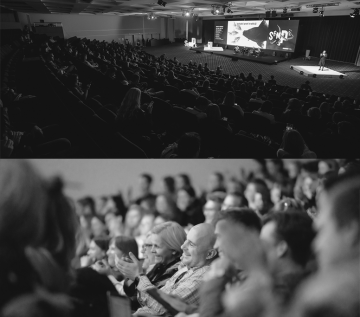2.12.2019

Last weekend, the 21st SEMPL Conference in Portorož was concluded, again offering an insight into the future of advertising and communication. From the appearances of the most sought-after and internationally recognized speakers, we have identified 10 trends that will shape advertising, marketing and business operations in 2020. It cannot be overlooked that in the coming trends we do not only talk about new technologies and the speed of adaptation to change, but also have to take time for silence, dialogue, authenticity, and rethinking for success.
- Including insight into the unconscious
Consumers do not make rational decisions and do not react as companies and brands expect. Although we have learned to seek and identify patterns of human behaviour through the collection and processing of data, this type of data does not reveal to us the causes that motivate particular behaviours. In addition, marketers have completely different habits regarding media consumption and use, and we conclude that modern marketing must necessarily include insight into the unconscious offered by psychological and behavioural studies and neurosciences. Lauren Kelly, a British design psychologist, believes that we can use a simple formula called LASER (»Like them«, »Attention-grabbing«, »Social«, »Easy«, Relevant«) to design relevant consumer products.
- Change focus: from ROI to emotions and creativity
Just as they are not rational consumers, advertising campaigns should not be, says Will Goodhand, the commercial director of System1 Group, who says: »When you create, do not let the left side of your brain stop you slow you down with its rationality«. Namely, the left side of your brain relies on facts, so creative solutions are usually dry and contain more abstract elements. The right brain works on the basis of emotion and intuition, so solutions are in-depth, innovative and creative, and advertising is more effective. »Creativity based on emotions remains one of the most effective long-term strategies. The best ways to build such an emotional connection are storytelling and humour«. says Chiara Manco, assistant editor for case studies at WARC, based on an analysis of best practice examples.
- The key to success lies in connecting
No innovation occurs at the individual level, as the numerous case studies on the greatest ideas in history and the way innovators stand in the background show. Greg Satell, one of the most important experts in the field of innovation, is convinced that in the future, it is good to write to those companies that find good, meaningful problems instead of ideas and can connect with others in finding solutions.
- Inspire the brand with passion and purpose
Today, more than ever, it is necessary to deviate from the average and to connect with people at the level of their values and beliefs. According to the latest findings, in order to become/remain culturally relevant, brands must address social issues and give back to the community. That is why you need to give your brand a voice that inspires confidence and passion and tells your stories consistently, says a creative songwriter Vikki Ross. This is followed by the new four P’s of marketing, as Phil Kemish, the award-winning marketing and speaker defines in his »Marketing with character«, i.e. Purpose, People, Passion, and Physical. The goal is to find and share values and beliefs, to connect with people, to understand what their passions are, and to create moments that converge.
- Traditional media remain important
The solution for effective advertising still lies in the mix of traditional and new media. »While the former build a brand, they connect emotionally with the consumer and achieve so-called mental availability, while others reach smaller, target-group-specific consumers more easily, enable better measurability and lead to so-called physical availability«. Samuel Scott, a columnist at The Drum, and Ivan Ivanov, director of marketing and communications for CEEMCA at Discovery said of the traditional and new media. The latter also stressed how important it is to find a common denominator for measuring reach in different media, and noted that ‘fashionable’ target groups, such as millennials, are great illusions. It is merely a demographic group that does not differ significantly from other generations in terms of media consumption, but we have attributed to them many unique characteristics that most do not possess.
- AI and conversational business
Trends in advanced forms of voice-activated ads based on the conversation between artificial intelligence and consumers are already beginning to address consumers of more responsive brands in the US, and UK. »In most cases, the voice is a tool of daily communication, and we achieve the desired goal or compromise through dialog, so I am sure this is also the right way to go in advertising,« says Simon Dunlop, a serial entrepreneur, currently offering these services through Instreamatic.com In 2020, artificial intelligence and dialog will also put the conversation channels under the communication channels you should not miss, and with them the messaging applications that are developing more and more solutions for personalized brand conversations with users.
- Also use sound and voice to attract attention
For more attention, remembrance and understanding of advertising and other media communication content, advertisers, agencies and others who want to attract the attention of consumers, listeners and viewers in one way or another need to pay more attention to sound and voice. Emma Rodero a researcher and professor Pompeu Fabra University in Spain, has proven that sound, intonation, way and speed of language are strongly linked to the degree of attention. »The problem with today’s advertisements is the words saturated content, which is pronounced too quickly and with incorrect intonation in a very short time, which does not demonstrably cause the desired reactions among consumers« Roder explains.
- Influencer marketing
Some of next year’s marketing resources should definitely be spent on influencer engagement, but it must be long-term or, as Matt Thorne the co-founder of the start-up Reboxed says, introduce influencer marketing instead of influencer marketing. It makes sense to integrate them into all segments of your campaign, not just separately within your social networks, and choose those that support your values. Do not miss out on the fastest growing TikTok platform currently available, with 500 million users. MG Empower’s founder Maira Genovese also recommends TikTok to advertisers, as individual video content succeeds in attracting the viewer’s attention for an average of 8 seconds much longer than any other social network.
- Change your mind set
Today, more than 50 percent of businesses face bad business due to a lack of value for users or consumers. If we try to avoid failures and want different results, it is necessary to leave the comfort zone and change our thinking. The well-known futurologist Jonathan MacDonald advises us to look for new business opportunities in areas where the government is confused, not where we are already acting alone or our competitors. That we must stop imitating the people around us and find what we really like says Ali Mahlodji: European Youth Ambassador, »No career path is a linear line. Mistakes, ups and downs are an integral part of a company that opens up new opportunities only for the brave«.
- Do not forget silence
Searches for social networks, obsession with data and efficiency, maximizing productivity in no time. All these are the causes of modern illnesses, work and life in constant noise, and ultimately it also takes us away from our desired goals. The power of silence gives us the opportunity to learn more: »Silence and peace are inextricably linked to creativity and can lead to revolutionary ideas«, says Erling Kagge, the first person to reach all three summits of the world on foot: the North and South Poles and Mount Everest. Silence as a tool for relaxed thinking is also successfully used by technological genius Elon Musk.
